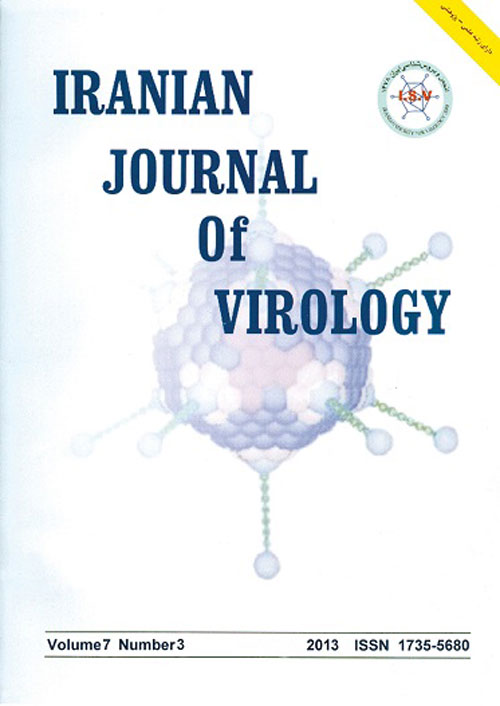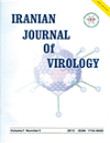فهرست مطالب

Iranian Journal of Virology
Volume:7 Issue: 3, 2013
- تاریخ انتشار: 1392/10/08
- تعداد عناوین: 5
-
-
Pages 1-6Background And AimsThe caspases are unique proteases that mediate the host cell apoptosis during viral infection. In this study, we identified the caspase cleavage motifs of H5N1 and H9N2 influenza viruses isolated during 1998-2012.Materials And MethodsAmino acid sequences of the eleven proteins encoded by the viruses as the caspase substrates downloaded from NCBI. The caspase cleavage motifs predicted at the three scanning P4P1, P4P2', and P14P10'–trained support vector machine classifier.ResultsData showed that H5N1 and H9N2 viruses were represented the same cleavage motif pattern for some of the viral proteins substrates. The HA, NP, and NS1 of H9N2 viruses were found to possess additional cleavage motifs from 2005, when an outbreak wave of H5N1 viruses was expanded through Asia.ConclusionMoreover, the cleavage motif of PB1-F2 protein was differing in both subtypes. The results indicated that the caspase activity of PB1-F2 protein may be involve in the viral pathogenicity.Keywords: Influenza virus, subtypes, Caspase Cleavage Motif, pathogenicity
-
Pages 7-11Background And AimsAvian metapneumovirus (aMPV) is RNA virus responsible for upper respiratory disease in poultry which is usually accompanied by secondary bacterial infections. In Iran, some molecular and serological studies indicated that aMPV infection occurred in commercial poultry industry.Materials And MethodsIn this study aMPV was molecularly identified and characterized in an affected broiler breeder flock. The well-vaccinated flock was suffering from a disease with clinical signs and a drop in egg production. After RNA extraction from tracheal and oropharyngeal samples, the presence of viral RNA was demonstrated by reverse transcription-polymerase chain reaction using primers specific to the attachment glycoprotein(G) gene. Positive samples were sequenced and phylogenetic tree based on sequences results was drawn. Based on sequences analysis, field strain of aMPV was recovered from the flock.ResultsPhylogenetic analysis showed that the virus (PCRLAB/HG2013) is located in B subtype cluster and is closely related to the aMPV strain that was previously detected in Iran (PCRLAB/HG2010) and other countries (Nigeria, Japan and Brazil).ConclusionThe results showed that field strain of aMPV has the potential to cause disease and economic losses in breeder broiler especially during egg production period. It is also concluded that vaccination against aMPV may not provide full protection in field situation and other control measurements including biosecurity should be taken.Keywords: Avian metapneumovirus, Iran, Phylogenetic analysis, Broiler Breeder
-
Pages 12-16Background And AimsRubella is a contagious viral disease mostly with mild clinical symptoms and often remains undiagnosed. Rubella infection may adversely affect pregnancy, especially in the first trimester and this mother to child transmission can cause congenital rubella and may be lead to permanent disability and mortality in children. Effective rubella vaccine should be prepared using suitable stabilizers. New stabilizers should be selected carefully in the manners that final product meet all requirements of stability, immunogenicity and safety. The aim of this study was to evaluate the immunogenicity of rubella vaccines that are formulated using two different new stabilizers in comparison to a commonly used vaccine that gelatin is used in it as a stabilizer.Materials And Methods28 guinea pigs were prospectively divided into four groups (one control and three test groups) according to the materials that they were subjected to receive, including the vaccines that formulated with hydrolyzed gelatin (G), Sorbitol (S) and Trehalose dehydrate (T) stabilizers. Control group was received sterile water for injection (WFI). Anti-rubella antibodies in the sera were measured using haemagglutination inhibition (HI) technique. The results were analyzed by Generalized Estimating equations (GEE) statistical test.ResultsOur results showed that all three formulated vaccines (G, S and T) induced seroconversion in guinea pigs; however the vaccine that contained Trehalose dehydrate (T) induced a slightly higher level of antibody against rubella virus (p<0.01).ConclusionAs an important part of final bulk of rubella vaccines, stabilizers are continuously studied to achieve safer, more stable and more effective vaccines. In this study, the immunogenicity of newly formulated rubella vaccines (T&S) was comparable to the vaccines which formulated with routine stabilizer (G).Keywords: Rubella virus, haemagglutination inhibition (HI), Seroconversion
-
Pages 17-21Background And AimsThe objective of this study was to investigate the effects of Newcastle Disease and Infectious Bronchitis vaccination programs in chickens. Materials and Methods andResultsIn the present study, 225 day-old broiler chicks divided into 5 groups. The groups were submitted to vaccinations, except for the non-vaccinated control group. The chickens in the groups 1 were kept as a control group and did not receive vaccine. The chickens in the group 2 were vaccinated with commercial mixed vaccine. The chickens in the groups 3 were vaccinated with two separate vaccines simultaneously. The chickens in the group 4 were vaccinated with single ND vaccine. The chickens in the groups 5 were vaccinated with single IB vaccine. Sera were collected at 18 and 45 days of age and submitted to serologic tests to assess antibody levels.ConclusionResults demonstrate that there is not any significant statistical difference between the vaccinated groups.Keywords: Immune response, Newcastle Disease, Infectious Bronchitis, Commercial mixed live vaccines (IBV+NDV), Broiler chicks
-
Pages 22-26Background And AimsAdenovector gene transfer induces inflammatory response that finally leads to vector removal from delivered site. The effect of hydrodynamic pre-injection on Adenovector mediated liver inflammation remained elusive.Materials And MethodsDifferent mice groups were pre-treated by hydrodynamic saline, dexamethasone or nothing prior to Adeno-Luciferase administration. Their samples were collected in 18 hours later and serum IL-1β level as a marker of inflammation was quantified. Also, liver histological assessment was performed to score the inflammatory grade. Results andConclusionIn spite of dexamethasone group, both hydrodynamic/Ad-Luc and Ad-Luc receiving groups induced the expression of IL-1β cytokine (p<0.05). The pathological views also indicated more inflammation and necrosis inside the different zones of liver tissue in these two adenovector injected groups. These results emphasized that Adenovector served as a suitable inflammatory model and hydrodynamic injection enhances this kind of inflammation.Keywords: Hydrodynamic injection, Adenoviral vector, Inflammation


